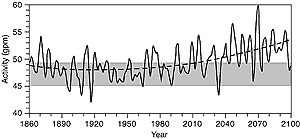9.3.6.3 Extra-tropical storms

Figure 9.30: Storm track activity averaged over north-west Europe
(6°W to 20°E, 40° to 70°N) in the ECHAM4/OPYC greenhouse gas scenario run
(Unit: gpm). A 4-year running mean is shown for smoother display. The grey
band indicates the variability of this index in the control run as measured
by one standard deviation. The non-linear climate trend optimally obtained
from quadratic curve fitting is marked by the dashed line; y-axis is activity
in gpm (geopotential metres) and x-axis is time in calendar years. From
Ulbrich and Christoph (1999). |
Storms not only have obvious effects on extremes of temperature
and precipitation, but also have severe impacts associated with wind, ocean
waves, etc. Due to model limitations in previous generations of global climate
models, until recently there have been few studies examining changes in extra-tropical
cyclones in a future climate. With the improved recent generation of global
climate models (see Chapter 8), such studies are now becoming
more credible. An analysis of an ensemble of four future climate change experiments
using a global coupled model with increased CO2 and sulphate aerosols showed
an increase in the number of deep low pressure systems in Northern Hemisphere
winter, while the number of weaker storms was reduced (Carnell and Senior, 1998).
Studies using different models show a similar change for both hemispheres (Sinclair
and Watterson, 1999) or for a study region limited to the North Atlantic (Knippertz
et al., 2000).
The reasons given for this common result are still under discussion. Carnell
and Senior (1998) ascribe it to a decrease in the mean meridional temperature
gradient in the future climate, with high latitudes warming more than low latitudes
(producing fewer storms), and greater latent heating in the moister atmosphere
(resulting in deeper lows). Sinclair and Watterson (1999) point to the reduced
mean sea level pressure and emphasise that vorticity as a measure of cyclone
strength does not increase. Knippertz et al.(2000) consider the increasing upper
tropospheric baroclinicity to be an important indicator of the change in surface
cyclone activity. They also detect an increasing number of strong wind events
in their simulation that can be assigned to the increasing number of deep lows.
Upper air storm track activity (defined as the standard deviation of the band
pass filtered 500 hPa height and related to the surface lows) has been found
to increase over the East Atlantic and Western Europe with rising greenhouse
gas forcing (such as seen in Figure 9.30 from Ulbrich
and Christoph, 1999).
They related this increase to a change in the NAO (see discussion of possible
NAO changes in Section 9.3.5.3). Several studies have
tried to look at mechanisms of changes (e.g., Lunkeit et al., 1998). For example,
Christoph et al. (1997) identify a mid-winter suppression of the North Pacific
storm track in present day climate which they attribute to very strong upper
level winds at that time of year. In a 3xCO2 climate model experiment, they
note that very intense upper level winds occur more often, thus producing a
more pronounced mid-winter suppression of the Pacific storm track.
Longer time-series from models have made the statistics more robust (e.g.,
Carnell and Senior, 1998). High-resolution models may improve the representation
of storms, but the present experiments are mainly too short to provide indications
of significant changes (e.g., Beersma et al., 1997). As can be seen, there are
now a growing number of studies addressing possible changes in storm activity,
but in spite of an emerging common signal there remains uncertainty with respect
to the governing mechanisms.
